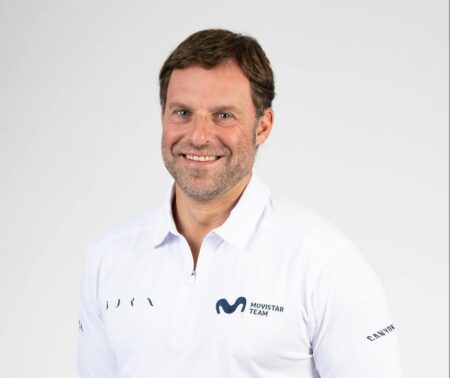Insights from Juan Pablo Molinero

In the 15 years since Movistar Team Cycling’s Chief Marketing Officer (CMO) Juan Pablo Molinero joined the famous Spanish cycling outfit, a lot has changed on and off the road. The team has upped the ante around fan engagement, particularly within its members’ Movistar Team Cycling Club, which he describes as a first of its kind for digital fandom in professional cycling.
Speaking from the team’s training camp just outside Valencia, Juan Pablo sat down with N3XT Sports to discuss how Movistar Team Cycling’s digital and data strategy has evolved over recent years, plus its race-plan for personalizing the cycling fan’s experience, both at in-person events and new ways for engaging those within the Movistar community who are, too, avid road cyclists.
- How has the Movistar Team Cycling marketing strategy and your role within the team evolved? What have been some of the key milestones?
In 2010, we simply didn’t have a website or any social media channels. We have created everything from zero. Now, we have 2.5 million followers. What it was ten years ago is nothing compared to how it is today. It has changed completely. Even though we are the oldest team in professional cycling, our team has changed dramatically within our marketing and communications.
Among our biggest milestones, we have been able to move from a traditional sponsorship concept, focused on visibility, to a modern sponsorship concept, which is already applied in other sports. This is the concept of treating our sponsors as real partners; providing them with, not only visibility, but plenty of things that sponsorship provides, including hospitality, VIP experiences, branded content.
We are like the external marketing department of those companies. They are very good at what they do, but we are there for their marketing needs in cycling.
- How have you enhanced the digital-fan relationship? How does the digital experience serve the Movistar Team Cycling fan in unique ways?
There are some challenging projects we currently have on the road. We have created our Movistar Team Cycling Club, and connected to that, our social media channels, which have allowed us to move from monologue-focused communications into becoming a dialogue-based team. Several years ago, it was simply about sending information out to the world. Today, it’s about how we can converse with our fans, our partners, and the media based all around the world. The most relevant move has been to change this monologue into a real dialogue.
- What is the Movistar Team Cycling Club? And how has it changed your marketing approach and engaged cycling enthusiasts with the brand?
The Movistar Team Cycling Club is about engagement; moving a little bit from our B2B business because we consider our customers to also be our sponsors. So, the fan club is helping us to move from this traditional business model into a slightly different hybrid B2B-B2C model. We have millions of fans and supporters all over the world, but – until now – we did not have a real tool to generate conversation, dialogue, and activities with them.
By generating the fan club, we don’t want to just tell the fan to listen to what we say, but for us to listen to what they have to tell us. They are fans of our team, so we want to give them something back. This includes activities and content, special prices, and promotions related to the bike industry.
- The advent of esports has closely aligned the fan and athlete experiences. From a marketing perspective, how does this inform your marketing strategy?
It’s been five years since we created the first e-team in the world of cycling. It was created because we firmly believe that the future of many sports – including the future of cycling – will move through a more “digital” way of understanding the sport. If you see video games for other sports, many are played with a joystick. With e-cycling, you do not play, you cycle. You feel fatigue. It’s like riding your bike on the road.
More people will practice cycling indoors and, by being the first cycling team to have a professional esports section, it has opened doors for us. It demonstrates that Movistar is innovating in this space and taking care of its own technology.
- Data management is a key process in sport’s digital transformation. How is fan, athlete, and business data enhancing the Movistar Team Cycling user experience?
For example, for 2025, most of our new projects are about data. We are creating an app to upload the hundreds and thousands of different data sources we have, from the riders to all the testing in the wind tunnels, of the materials, the weather forecast, plus team strategy. By putting all this information together, into one place, it helps make better predictions about what’s going to happen in a race. That’s one thing. Another is our efforts to offer a different fan experience in cycling, starting with our fan-club members.
As they do in Formula 1 and the information the sport shares with its fans, that’s not been the case in cycling until now. We want to go in that direction; to say to our fans, it’s not only about watching a race on TV, it’s about your favorite team offering you more information and to choose which information is most relevant to you. We can then accommodate better the information we share to each fan.
From the entertainment world, I would say this will be the next innovation in cycling and how it relates to TV broadcasting. In racing broadcasts, such as Formula 1, MotoGP, and the Americas Cup, it’s always about “data”. They show you the race but you get hundreds of different information points for the fans to choose from.
- With this in mind, how is Movistar Team Cycling able to diversify its audience reach regionally? What markets are driving new digital fans of Movistar and cycling?
We traditionally have the reference team for Spanish-speaking countries because we communicate most of our activities in Spanish. We are trying to increase our audience by using other languages that expose us to a wider audience in different countries. If I have to ask 2025 for something, I would like to increase the tools we have on hand to generate a real dialogue with fans.
- What’s next for Movistar Team Cycling?
Technology is going to be the most useful tool to do this, but not the only one. We also use online and offline activities and events to become a really reliable partner to our supporters. When you ask someone, “what do you think of the Movistar cycling team?”, I want them to be able to say they can talk with us, that we listen to them, and offer what I want as a cycling fan.
To summarise, we want to move from a 100 percent B2B business model and to introduce some B2C activities. If we can do that and help generate more revenues in B2C, I would be very happy with that in 2025.



